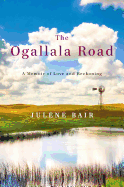
Julene Bair left the family farm in the high plains of Kansas for the bigger world of San Francisco, then the solitude of a rock house in the Mojave Desert. She returned to Kansas pregnant, worked with her father on the farm for as long as she could stand it, then found security in a cowboy town in Wyoming, where she raised her son alone. She returned again to tour the ever-diminishing creeks and springs on foot and to study the Ogallala Aquifer, which the United States relies upon for 30% of its irrigated crops. Next to a big cottonwood, she meets a cowboy who admires Cormac McCarthy--and falls in love.
For most of The Ogallala Road, this cowboy, Wade, accompanies Bair as she struggles to reconcile the wilderness-loving, liberal-minded, Subaru-driving writer she's become with her roots as a farmer's daughter of Kansas's conservative rural plains. The farm that has sustained generations of her forebears retains a strong hold on Bair's heart, and her family's--and her own--role in depleting the aquifer becomes a central source of conflict. The Ogallala Road meanders through the history of the Cheyenne Indians' longtime residence in the region, seeking insight into a more balanced relationship with earth and water.
In its combination of nature writing, environmental concern and love story, The Ogallala Road is unusual. Bair's contemplative praise of the high plains and the western deserts, her yearning for a father for her son and her lament for a dying way of life will strike chords for many readers. --Julia Jenkins, librarian and blogger at pagesofjulia

